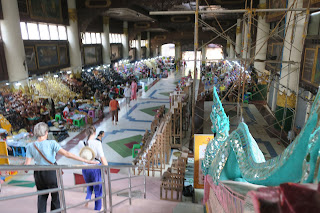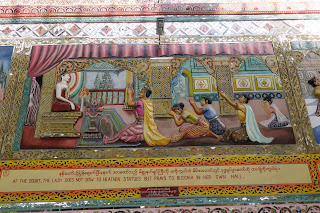The Shwethalyaung Temple is a Buddhist temple in the west side of Bago (Pegu),
Myanmar.
The Shwethalyaung Buddha is a reclining Buddha statue. The Buddha, which has a
length of 55 metres (180 ft) and a height of 16 metres (52 ft), is believed to
have been built in 994, during the reign of Mon King Migadepa. It was lost in
1757 when Pegu was pillaged.
During British colonial rule, in 1880, the Shwethalyaung Buddha was
rediscovered under a cover of jungle growth. Restoration began in 1881, and
Buddha's mosaic pillows (on its left side) were added in 1930.
|
Entering Shwethalyaung Temple.
|
|
Long corridor with stalls on each side.
Long corridor that goes from the east entrance to the Buddha statue.
|
|
Stairs that give access to the Buddha.
At the end of the long corridor are the stairs that give access to the
Buddha.
|
|
The stair handrails feature four large snakes.
|
|
Shwethalyaung Buddha.
The Shwethalyaung Buddha is a reclining Buddha statue. The Buddha, which
is the second largest in the world at a length of 55 metres (180 ft) and
a height of 16 metres (52 ft), is believed to have been built in 994.
-
A reclining Buddha is an image that represents Buddha lying down and
is a major iconographic theme in Buddhist art.
-
It represents the historical Buddha during his last illness, about to
enter the parinirvana.
-
He is lying on his right side, his head resting on a cushion or
relying on his right elbow, supporting his head with his hand.
-
See more at
Reclining Buddha - Wikipedia.
|
|
Plant of Buddha's feet.
Footprints of the Buddha often bear distinguishing marks, such as a
Dharmachakra at the centre of the sole, or the 32, 108 or 132 auspicious
signs of the Buddha, engraved or painted on the sole.
-
The veneration of the feet of gurus or deities was commonplace in
ancient India, placing one's head at or under their feet being a
ritual gesture signifying a hierarchy.
-
See more at
Buddha footprint - Wikipedia.
|
|
Nat spirit at the feet of Buddha.
This nat spirit is located northeast of Buddha.
|
|
Mural 1.
«King Migadeikpa (King of Hanthawady, 13th) who is ruling the country
and professing an erroneous creed, sends one of his sons to hunt in the
forest as a sacrifice.»
-
On the rear side of the plinth, in a series of 10 murals, the legend
of how the buddha came to be built by Mgadeikpa is depicted. His reign
was marked by corruption and violence, but one day his son was out
hunting in the forests when his eye fell upon a Mon girl who caused
his heart to flutter. Even though she was a Buddhist and he, like
everyone in his father’s kingdom, worshipped pagan idols, the two
became lovers and married after Mgadeikpa's son promised his love that
she could continue to practise Buddhism.
-
Back at the court, the king was furious when he discovered this and
ordered the execution of both the girl and his son. Yet when the new
bride prayed in front of the king's idol, it cracked and broke. The
king was seized with fear and, realising the error of his ways,
ordered the building of a statue of the buddha and the conversion of
the population to Buddhism.
|
|
Mural 2.
«As ordered by his father the King, the prince leaves for the forest
with companions and followers.»
|
|
Mural 3.
«On the way to the forest, in a village near Suvannabhumi, he meets a
Mon damsel named Dalahtaw, who is a follower of Buddha.»
|
|
Mural 4.
«The prince marries her with the promise that she will be allowed to
follow her own religion, and takes her back to the palace.»
|
|
Mural 5.
«At the court, the lady does not bow to heathen statues but prays to
Buddha in her own hall.»
|
|
Mural 6.
«Due to the slander against her by the heathen court officials, the king
gives order that she and her companions be killed as sacrifice to the
heathen gods.»
|
|
Mural 7.
«In front of the heathen statue worshipped by the king, the lady prays
to the three gems and makes a vow, which result in the statue breaking
into pieces.»
|
|
Mural 8.
«King Migadeikpa, suddenly seized with fear, regrets his wrong worship,
frees his son and his daughter in law and orders a statue of Buddha to
be placed for worship.»
|
|
Mural 9.
«According to the dictates of the king, the whole population gives up
their heathen worship, converts to Buddhism and builds a statue of
Buddha.»
|
|
Mural 10.
«King Migadeikpa now a follower of Buddha, completed the statue of
Buddha, in (994) A.D. now known as the Shwe Tha Lyaung Pagoda.»
|
|
Lokanat (Law Ka Nat).
Law Ka Nat is a deity in Myanmar, who is revered by the Burmese as a
celestial peacemaker and usually depicted seated on a giant lotus leaf,
whilst holding a pair of small ching-like hand cymbals with her feet.
-
To the people of Myanmar, Kuan Yin is no foreign to them; she is the
one they much revered as Lokanat who brings peace and prosperity to
the Nation.
-
The throne of the Myanmar king placed the Lokanat on both sides of the
throne.
-
See more at
Lion Throne of Burma - Wikipedia.
|
|
Headboard with paintings.
|
|
Nat spirit next to the head of Buddha.
This nat spirit is located southeast of Buddha.
|
|
Buddha (left) and nat spirit (right).
|
|
Nat spirit (left) and Buddha (right).
|
|
Head of Shwethalyaung Buddha.
|
|
Altar with flowers next to Buddha's head.
|
|
Poster with dimensions.
Poster with the dimensions of the different parts of Shwethalyaung
Buddha.
|
|
Leaving Shwethalyaung Temple.
|
See also
Source
Location




































